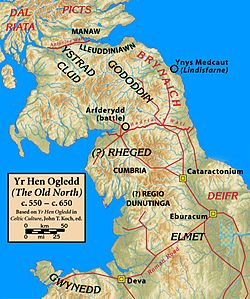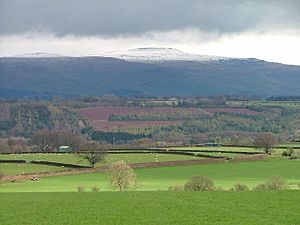Rheged facts for kids
Quick facts for kids
Kingdom of Rheged
|
|||||||||||
|---|---|---|---|---|---|---|---|---|---|---|---|
| c.500–c. 600 | |||||||||||

Yr Hen Ogledd (The Old North) c. 550 – c. 650.
|
|||||||||||
| Capital | Carlisle | ||||||||||
| Common languages | |||||||||||
| Government | Monarchy | ||||||||||
|
•
|
Meirchion Gul | ||||||||||
|
•
|
Cynfarch Oer | ||||||||||
|
•
|
Urien | ||||||||||
|
|||||||||||
| Today part of | United Kingdom | ||||||||||

Rheged was an important kingdom in the "Old North" (called Hen Ogledd). This was a region in what is now Northern England and southern Scotland. People there spoke a language called Brittonic, which is related to modern Welsh. Rheged existed after the Roman Empire left Britain and during the Early Middle Ages.
We know about Rheged from old poems and stories, but these don't tell us exactly where its borders were. For a long time, people thought Rheged was mainly in Cumbria, England. However, new discoveries suggest its main stronghold might have been in Galloway, Scotland. Rheged's people spoke Cumbric, a language very similar to Old Welsh.
Contents
What Does the Name Rheged Mean?
The meaning of the name Rheged is a bit of a mystery. One idea is that it comes from old Brittonic words meaning "great wood" or "great forest." Another idea is that it means something like "generosity." Historians are still working to figure out the exact meaning.
Where Was Rheged Located?
Rheged is often linked to a king named Urien. He ruled in the late 500s. Old Welsh poems and family trees often call him "Urien Rheged." This shows how closely he was connected to the kingdom.
Urien fought against the Angles from a kingdom called Bernicia. A famous poet named Taliesin wrote about Urien's victories. Taliesin called Urien the "Ruler of Rheged." This places Urien and his kingdom in the North of Britain. Some writings suggest he ruled the Lyvennet Valley in what is now Westmorland.
Later stories connect Urien to the city of Carlisle. This city was a Roman town called Luguvalium. Many historians believe Rheged covered much of modern Cumbria.
New Ideas About Rheged's Location
Some place names, like Dunragit in Dumfries and Galloway, Scotland, might mean "Fort of Rheged." This suggests that Rheged once included parts of Scotland.
Recent digs at Trusty's Hill in Galloway have found exciting clues. This old fort might have been the center of Rheged around the year 600 AD. This discovery challenges the older idea that Rheged was only in Cumbria.
Some historians even think Rheged might have reached as far south as Rochdale in Greater Manchester. However, this idea is less certain. It's possible these places were just near Rheged's borders. We do know that Urien's kingdom stretched east at one point, as he was also called "Ruler of Catraeth" (which is Catterick in North Yorkshire).
Who Were the Kings of Rheged?
The royal family of Rheged traced their history back to a figure named Coel Hen. Some people think he might be the original "Old King Cole" from folk tales! He might have ruled a large part of the North in the early 400s.
Here are some of the kings who might have ruled Rheged:
- Meirchion Gul: He was the father of Cynfarch.
- Cynfarch Oer: Also known as Cynfarch the Dismal, he was Urien's father.
- Urien Rheged (around 550 – 590 AD): He is the most famous king. Eight songs by the poet Taliesin are about him.
- Owain: Urien's son, also known for fighting the Bernicians.
There might have been two later kings:
- Rhun: Said to be Urien's son. He might have been a godfather to Edwin of Northumbria.
- Royth (also called Rhaith): Rhun's son, and possibly the last king of Rheged.
How Did Rheged End?
Rheged became part of the kingdom of Northumbria sometime before 730 AD. Northumbria was formed when two other kingdoms, Bernicia and Deira, joined together.
It might have been a peaceful joining. Around 638 AD, Prince (who later became King) Oswiu of Northumbria married Rieinmelth. She was a princess from Rheged and the granddaughter of Rhun. This marriage could have meant that both kingdoms were inherited by the same person.
After Rheged joined Northumbria, the old Cumbric language slowly disappeared. It only survived in very remote areas. Around 900 AD, after Viking attacks weakened Northumbria, large parts of the area came under the control of the British Kingdom of Strathclyde. This might show that British culture still had a strong presence there.
The area of Cumbria stayed under Strathclyde's control until the early 1000s. Then, Strathclyde itself became part of the Scottish kingdom. The name of the people, Cymry (which means "fellow countrymen" in Welsh), survived in the names Cumberland and now Cumbria.
Discovery of a Lost Stronghold
For a long time, people thought Rheged's main center was in Cumbria, England. But in 2012, archaeologists found exciting new evidence at Trusty's Hill in Galloway, southwest Scotland. This site might have been Rheged's capital around 600 AD. The discovery was announced in 2017, and digs are still happening.
Ronan Toolis, one of the lead researchers, said they found ruins of a strong fort on the hill. It had stone walls reinforced with timber. This kind of fort was used by important rulers in the early Middle Ages. Toolis believes this evidence strongly suggests that Galloway was the heart of the Kingdom of Rheged.
Genetic Legacy of Rheged
A study by the University of Oxford called "People of the British Isles" found something interesting. The original people of Rheged might have left a special genetic mark on the people of Cumbria today.
The study looked at the DNA of over 2000 people whose grandparents were all born close to each other. They found that in some cases, groups of people with similar DNA matched the locations of old historical kingdoms, like Rheged. This suggests that the ancient people of Rheged have a lasting genetic heritage in the area.
Images for kids
-
The Eden Valley is thought by some to have been the heartland of the kingdom of Rheged.



